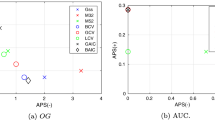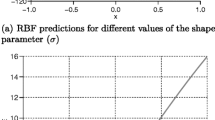Abstract
This paper presents a general approach toward the optimal selection and ensemble (weighted average) of kernel-based approximations to address the issue of model selection. That is, depending on the problem under consideration and loss function, a particular modeling scheme may outperform the others, and, in general, it is not known a priori which one should be selected. The surrogates for the ensemble are chosen based on their performance, favoring non-dominated models, while the weights are adaptive and inversely proportional to estimates of the local prediction variance of the individual surrogates. Using both well-known analytical test functions and, in the surrogate-based modeling of a field scale alkali-surfactant-polymer enhanced oil recovery process, the ensemble of surrogates, in general, outperformed the best individual surrogate and provided among the best predictions throughout the domains of interest.
Similar content being viewed by others
References
Balabanov VO, Haftka RT, Grossman B, Mason WH, Watson LT (1998) Multidisciplinary response model for HSCT wing bending material weight. In: 7th AIAA/ USAF/NASA/ISSMO symposium on multidisciplinary analysis and optimization, St. Louis, MO, AIAA Paper 98-4804
Bishop C (1995) Neural networks for pattern recognition. Oxford University Press, Oxford
Bourrel M, Salager JL, Schechter RS, Wade WH (1980) A correlation for phase behavior of nonionic surfactants. J Colloid Interface Sci 75(2):451–461
Buckland ST, Burnham KP, Augustin NH (1997) Model selection: an integral part of inference. Biometrics 53:275–290
Carrero E, Queipo N, Pintos S, Zerpa L (2007) Global sensibility analysis of asp enhanced oil recovery process. J Pet Sci Eng doi:10.1016/j.petrol.2006.11.007
Cherkassky V, Ma Y (2003) Comparison of model selection for regression. Neural Comput 15:1691–1714
Cherkassky V, Ma Y (2004) Practical selection of SVM parameters and noise estimation for SVM regression. Neural Netw 17(1):113–126
Cherkassky V, Shao X, Mulier F, Vapnik V (1999) Model complexity control for regression using VC generalization bounds. IEEE Trans Neural Netw 10(5):1075–1089
Clarke SM, Griebsch JH, Simpson TW (2005) Analysis of support vector regression for approximation of complex engineering analyses. ASME J Mech Des 127(6):1077–1087
Craig KJ, Stander N, Dooge DA, Varadappa S (2002) MDO of automotive vehicles for crashworthiness using response surface methods. In: 9th AIAA/ISSMO symposium on multidisciplinary analysis and optimization, Atlanta, GA, AIAA Paper 2002-5607
Dosher TM, Wise FA (1976) Enhanced oil recovery potential: an estimate. J Pet Technol, p 575, Paper SPE 5800
Engelsen S, Lake LW, Lin EC, Ohno T, Pope GA, Camilleri D, Sepehrnoori K (1987) Description of an improved compositional micellar/polymer simulator. Paper SPE 13967, SPE Reserv Eng 427–432
Girosi F (1998) An equivalence between sparse approximation and support vector machines. Neural Comput 10(6):1455–1480
Giunta AA, Balabanov V, Grossman B, Burgee S, Haftka RT, Mason WH, Watson LT (1997) Multidisciplinary optimization of a supersonic transport using design of experiments theory and response surface modelling. Aeronaut J 101(1008):347–356
Goel T, Haftka RT, Shyy W, Queipo NV (2007) Ensemble of surrogates. Struct Multidisc Optim 33(3):199–216
Gunn SR (1998) Matlab support vector machine toolbox. http://www.isis.ecs.soton.ac.uk/isystems/kernel (Mar)
Hernández C, Chacón L, Anselmi L, Baldonedo A, Qi J, Phillip C, Pitts MJ (2001) ASP system design for an offshore application in the La Salina Field, Lake Maracaibo. In: SPE latin american and caribbean petroleum engineering conference, Buenos Aires, Argentina, Paper SPE 69544, March 2001
Hoeting J, Madigan D, Raftery A, Volinsky CT (1999) Bayesian model averaging: a tutorial. Stat Sci 14(4):382–417
Jin R, Chen W, Simpson TW (2001) Comparative studies of metamodelling techniques under multiple modelling criteria. Struct Multidisc Optim 23(1):1–13
Kass RE, Raftery AE (1995) Bayes factors. J Am Stat Assoc 90:773–795
Krogh A, Sollich P (1997) Statistical Mechanics of Ensemble Learning. Phys Rev E 55(1):811–825
Kurtaran H, Eskandarian A, Marzougui D, Bedewi NE (2002) Crashworthiness design optimization using successive response surface approximations. Comput Mech 29:409–421
Lake LW (1989) Enhanced oil recovery. Prentice Hall, Englewood Cliffs, NJ
Lake LW, Bhuyan D, Pope GA (1990) Mathematical modelling of high-ph chemical flooding. SPE Paper 17398, SPE Reserv Eng 213–220
Li W, Padula S (2004) Approximation methods for conceptual design of complex systems. In: Schumaker L, Chui C, Neaumtu M (eds) Eleventh international conference on approximation theory, May 2004
Madigan D, Raftery AE (1994) Model selection and accounting for model uncertainty in graphic models using Occam’s window. J Am Stat Assoc 89:1535–1546
Manrique E, De Carvajal G, Anselmi L, Romero C, Chacón L (2000) Alkali/Surfactant/Polymer at VLA 6/9/21 field in Maracaibo Lake: experimental results and pilot project design. In: SPE/DOE improved oil recovery symposium, Tulsa, OK, Paper SPE 59363, April 2000
Martin JD, Simpson TW (2005) On the use of kriging models to approximate deterministic computer models. AIAA J 43(4):853–863
Müller K, Mika S, Rätsch G, Tsuda K, Schölkopf B (2001) An introduction to kernel-based learning algorithms. IEEE Trans Neural Netw 12(2):181–201
Perrone M (1994) General averaging results for convex optimization. In: Mozer MC et al. (ed) Proceedings of the 1993 connectionist models summer school. Erlbaum, Hillsdale, NJ
Perrone M, Cooper L (1993) When networks disagree: ensemble methods for hybrid neural networks. In: Mammone RJ (ed) Artificial neural networks for speech and vision. Chapman & Hall, FL, pp 126–142
Poggio T, Smale S (2003) The mathematics of learning: dealing with data. Not Am Math Soc 50(5):537–544
Pope GA, Nelson RC (1978) A chemical flooding compositional simulator. Paper SPE 6725, Soc Pet Eng J, p 18
Qi Q, Hongjun G, Dongwen L, Ling D (2000) The pilot test of ASP combination flooding in Karamay oil field. In: SPE international oil and gas conference an exhibition, Beijing, China, Paper SPE 64726, November 2000
Queipo NV, Haftka R, Shyy W, Goel T, Vaidyanathan R, Kevin Tucker P (2005) Surrogate-based analysis and optimization. J Progress Aerospace Sci 41:1–28
Queipo NV, Goicochea J, Pintos S (2002) Surrogate modeling-based optimization of SAGD processes. J Pet Sci Eng 35 (1–2):83–93
Queipo NV, Verde A, Canelón J, Pintos S (2002) Efficient global optimization of hydraulic fracturing designs. J Pet Sci Eng 35(3–4):151–166
Salager JL (1996) Quantifying the concept of physico-chemical formulation in surfactant–oil–water systems-state of the art. Progr Colloid Polym Sci 100:137–142
Salager JL, Bourrel M, Schechter RS, Wade WH (1979a) Mixing rules for optimum phase behavior formulation of surfactant–oil–water systems. Soc Pet Eng J 19:271–278
Salager JL, Morgan J, Schechter RS, Wade WH, Vasquez E (1979b) Optimum formulation of surfactant-oil-water systems for minimum tension and phase behavior. Soc Pet Eng J 19:107–115
Schölkopf B, Smola AJ (2002) Learning with kernels. MIT Press, Cambridge, MA
Simpson TW, Peplinski JD, Koch PN, Allen JK (2001) Metamodels for computer based engineering design: survey and recommendations. Eng Comput 17(2):129–150
UTCHEM-9.0. (2000) Utchem-9.0 a three-dimensional chemical flood simulator. http://www.cpge.utexas.edu/utchem/ (Jul)
Vapnik V (1998) Statistical learning theory. Wiley, New York
Wahba G (2000) An introduction to model building with reproducing kernel Hilbert spaces. Technical Report 1020, University of Wisconsin-Madison Statistics Department (Apr)
Wei-Ju W (1996) Optimum design of field-scale chemical flooding using reservoir simulation. PhD thesis, The University of Texas at Austin, TX
Zerpa L, Queipo NV, Pintos S, Salager J (2005) An optimization methodology of alkaline-surfactant-polymer flooding processes using field scale numerical simulation and multiple surrogates. J Pet Sci Eng 47:197–208
Zhijian Q, Yigen Z, Xiansong Z, Jialin D (1998) A successful ASP flooding in gudong oil field. In: SPE/DOE Improved Oil Recovery Symposium, Tulsa, OK, Paper SPE 39613, April 1998
Author information
Authors and Affiliations
Corresponding author
Additional information
This work was supported in part by the Fondo Nacional de Ciencia, Tecnología e Innovación (FONACIT), Venezuela under Grant F-2005000210. N. Q. Author also acknowledges that this material is based upon work supported by National Science Foundation under Grant DDM-423280.
Rights and permissions
About this article
Cite this article
Sanchez, E., Pintos, S. & Queipo, N.V. Toward an optimal ensemble of kernel-based approximations with engineering applications. Struct Multidisc Optim 36, 247–261 (2008). https://doi.org/10.1007/s00158-007-0159-6
Received:
Revised:
Accepted:
Published:
Issue Date:
DOI: https://doi.org/10.1007/s00158-007-0159-6




